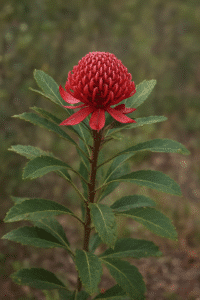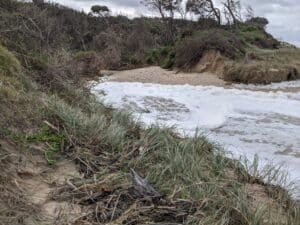When torrential rains sweep across New South Wales and rivers surge past their banks, it isn’t just engineered solutions that keep our landscapes intact—some of the true heroes are humble native plants. Meet the Lomandra: a tough, resilient grass-like plant that’s quietly making waves (and stopping them!) by stabilising riverbanks and embankments during floods.
What are Lomandras and which ones to plant?
Lomandras are a genus of perennial, tufted grasses native to Australia. With their elegant, strappy green leaves and deep, fibrous root systems, they’re often seen in gardens, parks, and, importantly, along waterways. There are several species of Lomandra, with Lomandra longifolia and Lomandra hystrix being the most widely used in erosion control across NSW. Speak to your Local Landcare Coordinator or council nursery for more information on your local species.
The Problem: Flood Erosion in NSW
New South Wales is no stranger to heavy rainfall and periodic flooding. When rivers rise and fall rapidly, the force of the water can erode soil from riverbanks, lead to the collapse of embankments, and wash away valuable topsoil. This erosion doesn’t just damage the environment—it threatens infrastructure, alters habitats, and can put communities at risk.
Traditional flood management often relies on hard engineering—think concrete walls, gabions, or riprap. While these solutions are effective, they can also be expensive, visually intrusive, and sometimes even harmful to local ecosystems. That’s where Lomandras come in.
How Lomandras Work Their Magic
So how do Lomandras help stabilise banks during floods? It comes down to their incredible root systems. Lomandra roots grow deep and wide, weaving through the soil like a natural net. This network not only binds the soil together, reducing the risk of washout, but also helps absorb some of the energy from fast-moving water.
- Soil Reinforcement: The dense roots of lomandra act as living anchors, holding soil in place even under the stress of floodwaters.
- Water Filtration: As water flows over and through lomandra stands, the plants trap sediment and filter out pollutants, improving water quality downstream.
- Habitat Creation: By stabilising banks, Lomandras help preserve habitat for native wildlife, from frogs to insects to birds. They also provide shelter for a variety of small ground dwelling mammals, birds and reptiles, some of which also eat the seeds.
- Rapid Recovery: After a flood event, Lomandras bounce back quickly, preventing weed invasion and further erosion.
Lomandras in Action: Real Stories from NSW
Across New South Wales, local councils, Landcare groups, and environmental agencies have been turning to Lomandras as part of their flood resilience strategies. Take the Hawkesbury-Nepean catchment, for example, where repeated flooding has threatened farmland and communities. Here, Lomandra plantings along creek lines and riverbanks have proven remarkably effective at reducing erosion and protecting valuable land.
In the Illawarra region, Lomandra has been used to stabilise slopes adjacent to urban developments, where rapid runoff from storms can cause severe bank failure. By integrating lomandra into revegetation projects, councils have not only improved slope stability but also enhanced the area’s natural beauty and biodiversity.
Why Lomandra is often the Ideal Choice
There are plenty of reasons Lomandra is favoured for flood mitigation in NSW:
- Drought Tolerance: Lomandra survives both wet and dry periods, making it ideal for Australia’s variable climate.
- Low Maintenance: Once established, Lomandra needs little care—no mowing, little watering, and it’s resistant to most pests and diseases.
- Non-Invasive: Unlike some exotic grasses used in erosion control, local species of Lomandra won’t run rampant or outcompete native species.
- Beauty and Biodiversity: The spiky green sprays of Lomandra look attractive year-round, and their yellow, honey-scented flowers attract pollinators and support wildlife.
During the first year, keep weeds in check and water as needed. Once established, Lomandra will thrive with minimal attention.
Lomandra and First Nations peoples
Lomandra is the plant that keeps on giving. It was a coveted food source for Aboriginal peoples who chewed the white succulent bases of the leaves and also ate the seed (whole or ground into a flour and made into patties that were cooked on the fire). The strappy leaves were also a culturally significant fibre source, used in the weaving of baskets, nets and eel traps and the roots could be used to treat bites and stings.
Lomandra and Community Involvement
One of the most inspiring aspects of Lomandra’s role in flood management is community participation. Across NSW, Landcare groups and volunteers regularly organise planting days, bringing together people of all ages to help restore natural resilience to local waterways.
These efforts go beyond just stabilising banks: they foster a sense of stewardship, connect people to the land, and provide practical education about the importance of native plants in environmental management.
Looking Ahead: Lomandra in a Changing Climate
With climate change predicted to bring more frequent and intense flood events to NSW, the role of Lomandra and other native plants in flood management will only grow in importance. By embracing nature-based solutions like Lomandra plantings, we can build landscapes that are more resilient, more beautiful, and better able to withstand the storms ahead.
So next time you see a lush, green band of Lomandra waving along a riverbank, remember: those tufts aren’t just for show—they’re holding the land together, one flood at a time.
Let’s Spread the Word!
If you’ve seen Lomandra in action, share your experiences and photos! Let’s raise awareness about the power of native plants to protect our communities. #Lomandra #NSWFloods #SoilStabilisation #NatureBasedSolutions #RiverbankResilience
Article by Natacha Evans, 2025




